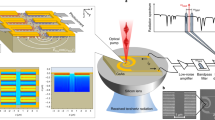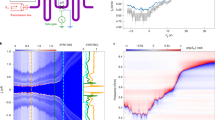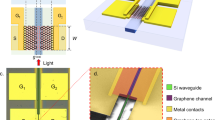Abstract
Spectacular advances in heterodyne astronomy1,2 have been largely due to breakthroughs in detector technology3. To exploit the full capacity of future terahertz (∼300 GHz–5 THz) telescope space missions4, new concepts of terahertz coherent receivers are needed, providing larger bandwidths and imaging capabilities with multipixel focal plane heterodyne arrays5. Here we show that graphene uniformly doped to the Dirac point, with material resistance dominated by quantum localization and thermal relaxation governed by electron diffusion, enables highly sensitive and wideband coherent detection of signals from 90 to 700 GHz and, prospectively, across the entire terahertz range. We measure on proof-of-concept graphene bolometric mixers an electron diffusion-limited gain bandwidth of 8 GHz (corresponding to a Doppler shift of 480 km s−1 at 5 THz) and intrinsic mixer noise temperature of 475 K (which would be equivalent to ~2 hf/kB at f = 5 THz, where h is Planck’s constant, f is the frequency and kB is the Boltzmann constant), limited by the residual thermal background in our setup. An optimized device will result in a mixer noise temperature as low as 36 K, with the gain bandwidth exceeding 20 GHz, and a local oscillator power of <100 pW. In conjunction with the emerging quantum-limited amplifiers at the intermediate frequency6,7, our approach promises quantum-limited sensing in the terahertz domain, potentially surpassing superconducting technologies, particularly for large heterodyne arrays.
This is a preview of subscription content, access via your institution
Access options
Access Nature and 54 other Nature Portfolio journals
Get Nature+, our best-value online-access subscription
$29.99 / 30 days
cancel any time
Subscribe to this journal
Receive 12 digital issues and online access to articles
$119.00 per year
only $9.92 per issue
Buy this article
- Purchase on Springer Link
- Instant access to full article PDF
Prices may be subject to local taxes which are calculated during checkout



Similar content being viewed by others
Data availability
The authors declare that the main data supporting the findings of this study are available within the article and its Supplementary Information files. Additional data is available from the corresponding author upon request.
Change history
26 November 2019
An amendment to this paper has been published and can be accessed via a link at the top of the paper.
References
Rowan-Robinson, M. Probing the cold Universe. Science 325, 546–547 (2009).
Young, E. T. et al. Early science with SOFIA, the Stratospheric Observatory for Infrared Astronomy. Astrophys. J. Lett. 749, L17 (2012).
de Graauw, T. et al. The Herschel-Heterodyne Instrument for the Far-Infrared (HIFI). Astron. Astrophys. 518, L6 (2010).
Battersby, C. et al. The Origins Space Telescope. Nat. Astron. 2, 596–599 (2018).
Goldsmith, P. F. Sub-millimeter heterodyne focal-plane arrays for high-resolution astronomical spectroscopy. Radio Sci. Bull. 362, 53–73 (2017).
White, T. C. et al. Traveling wave parametric amplifier with Josephson junctions using minimal resonator phase matching. Appl. Phys. Lett. 106, 242601 (2015).
Ho Eom, B., Day, P. K., Leduc, H. G. & Zmuidzinas, J. A wideband, low-noise superconducting amplifier with high dynamic range. Nat. Phys. 8, 623–627 (2012).
Blain, A. W., Smail, I., Ivison, R. J., Kneib, J. P. & Frayer, D. T. Submillimeter galaxies. Phys. Rep. 369, 111–176 (2002).
Madau, P. & Dickinson, M. Cosmic star formation history. Annu. Rev. Astron. Astrophys. 52, 415–486 (2014).
Klapwijk, T. M. & Semenov, A. V. Engineering physics of superconducting hot-electron bolometer mixers. IEEE Trans. Terahertz Sci. Technol. 7, 627–648 (2017).
Prober, D. E. Superconducting terahertz mixer using a transition-edge microbolometer. Appl. Phys. Lett. 62, 2119–2121 (1993).
Gershenzon, E. M. et al. Millimeter and submillimeter range mixer based on electronic heating of superconducting films in the resistive state. Sov. Phys. Supercond. 3, 1582–1597 (1990).
Krause, S. et al. Noise and IF gain bandwidth of a balanced waveguide NbN/GaN hot electron bolometer mixer operating at 1.3 THz. IEEE Trans. Terahertz Sci. Technol. 8, 365–371 (2018).
Novoselov, E. & Cherednichenko, S. Low noise terahertz MgB2 hot-electron bolometer mixers with an 11 GHz bandwidth. Appl. Phys. Lett. 110, 032601 (2017).
El Fatimy, A. et al. Epitaxial graphene quantum dots for high-performance terahertz bolometers. Nat. Nanotechnol. 11, 335–338 (2016).
Cai, X. et al. Sensitive room-temperature terahertz detection via the photothermoelectric effect in graphene. Nat. Nanotechnol. 9, 814–819 (2014).
Mittendorff, M. et al. Ultrafast graphene-based broadband THz detector. Appl. Phys. Lett. 103, 021113 (2013).
McCann, E. et al. Weak-localization magnetoresistance and valley symmetry in graphene. Phys. Rev. Lett. 97, 146805 (2006).
Aleiner, I. L. & Efetov, K. B. Effect of disorder on transport in graphene. Phys. Rev. Lett. 97, 236801 (2006).
Lara-Avila, S. et al. Disordered Fermi liquid in epitaxial graphene from quantum transport measurements. Phys. Rev. Lett. 107, 166602 (2011).
Novoselov, K. S. et al. Electric field effect in atomically thin carbon films. Science 306, 666–669 (2004).
Novoselov, K. S. et al. Two-dimensional gas of massless Dirac fermions in graphene. Nature 438, 197–200 (2005).
Zhang, Y., Tan, Y.-W., Stormer, H. L. & Kim, P. Experimental observation of the quantum Hall effect and Berry’s phase in graphene. Nature 438, 201–204 (2005).
Ponomarenko, L. A. et al. Tunable metal–insulator transition in double-layer graphene heterostructures. Nat. Phys. 7, 958–961 (2011).
Efetov, D. K. et al. Fast thermal relaxation in cavity-coupled graphene bolometers with a Johnson noise read-out. Nat. Nanotechnol. 13, 797–801 (2018).
He, H. et al. Uniform doping of graphene close to the charge neutrality point by polymer-assisted spontaneous assembly of molecular dopants. Nat. Commun. 9, 3956 (2018).
Balandin, A. A. Thermal properties of graphene and nanostructured carbon materials. Nat. Mater. 10, 569–581 (2011).
Kubakaddi, S. S. Interaction of massless Dirac electrons with acoustic phonons in graphene at low temperatures. Phys. Rev. B 79, 075417 (2009).
Baker, A. M. R. et al. Energy loss rates of hot Dirac fermions in epitaxial, exfoliated, and CVD graphene. Phys. Rev. B 87, 045414 (2013).
Narozhny, B. N., Gornyi, I. V., Titov, M., Schütt, M. & Mirlin, A. D. Hydrodynamics in graphene: linear-response transport. Phys. Rev. B 91, 035414 (2015).
Foster, M. S. & Aleiner, I. L. Slow imbalance relaxation and thermoelectric transport in graphene. Phys. Rev. B 79, 085415 (2009).
Müller, M., Fritz, L. & Sachdev, S. Quantum-critical relativistic magnetotransport in graphene. Phys. Rev. B 78, 115406 (2008).
Crossno, J. et al. Observation of the Dirac fluid and the breakdown of the Wiedemann–Franz law in graphene. Science 351, 1058–1061 (2016).
Wang, L. et al. One-dimensional electrical contact to a two-dimensional material. Science 342, 614–617 (2013).
Ekström, H., Karasik, B. S., Kollberg, E. L. & Yngvesson, K. S. Conversion gain and noise of niobium superconducting hot-electron-mixers. IEEE Trans. Microw. Theory Tech. 43, 938–947 (1995).
Martin, F., Vermeulen, G., Camus, P. & Benoit, A. A closed cycle 3He–4He dilution refrigerator insensitive to gravity. Cryogenics 50, 623–627 (2010).
Yates, S. J. C. et al. Photon noise limited radiation detection with lens-antenna coupled microwave kinetic inductance detectors. Appl. Phys. Lett. 99, 073505 (2011).
Buchel, D. et al. 4.7-THz superconducting hot electron bolometer waveguide mixer. IEEE Trans. Terahertz Sci. Technol. 5, 207–214 (2015).
Yager, T. et al. Express optical analysis of epitaxial graphene on SiC: impact of morphology on quantum transport. Nano Lett. 13, 4217–4223 (2013).
Acknowledgements
We thank J. Conway and E. De Beck for illuminating discussions, and A. Tzalenchuk, J. F. Schneiderman and T. Claeson for critical reading of the manuscript. This work was jointly supported by the Swedish Foundation for Strategic Research (SSF) (nos. IS14-0053, GMT14-0077, RMA15-0024), Knut and Alice Wallenberg Foundation, Chalmers Area of Advance NANO, the Swedish Research Council (VR) 2015-03758 and 2016-04828, the Swedish-Korean Basic Research Cooperative Program of the NRF (no. NRF-2017R1A2A1A18070721) and the European Union’s Horizon 2020 research and innovation programme (grant agreement no. 766714/HiTIMe).
Author information
Authors and Affiliations
Contributions
S.L.-A., H.H., K.H.K. and R.Y. contributed to sample growth and device fabrication. S.L.-A., H.H., K.H.K, F.L. and T.B. performed the d.c. characterization of the device. D.G. developed the theoretical calculations. A.D. and S.C. characterized the sample at THz and microwave frequency ranges. D.G., S.L.-A., A.D., S.C. and S.K. contributed to the interpretation of the experiments. S.K., S.L.-A. and S.C. conceived and designed the experiment. All the authors contributed to the writing of the manuscript.
Corresponding author
Ethics declarations
Competing interests
The authors declare no competing interests.
Additional information
Peer review information Nature Astronomy thanks Peter Roelfsema and the other, anonymous, reviewer(s) for their contribution to the peer review of this work.
Publisher’s note Springer Nature remains neutral with regard to jurisdictional claims in published maps and institutional affiliations.
Supplementary information
Supplementary Information
Supplementary Figs. 1–8, Supplementary text and Supplementary references.
Rights and permissions
About this article
Cite this article
Lara-Avila, S., Danilov, A., Golubev, D. et al. Towards quantum-limited coherent detection of terahertz waves in charge-neutral graphene. Nat Astron 3, 983–988 (2019). https://doi.org/10.1038/s41550-019-0843-7
Received:
Accepted:
Published:
Issue Date:
DOI: https://doi.org/10.1038/s41550-019-0843-7
This article is cited by
-
Hybrid Dirac semimetal-based photodetector with efficient low-energy photon harvesting
Light: Science & Applications (2022)
-
Recent progress in optoelectronic applications of hybrid 2D/3D silicon-based heterostructures
Science China Materials (2022)



